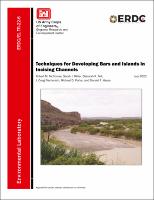Please use this identifier to cite or link to this item:
https://hdl.handle.net/11681/44720Full metadata record
| DC Field | Value | Language |
|---|---|---|
| dc.contributor.author | McComas, Robert M. | - |
| dc.contributor.author | Miller, Sarah J. | - |
| dc.contributor.author | Felt, Deborah R. | - |
| dc.contributor.author | Fischenich, J. Craig, 1962- | - |
| dc.contributor.author | Porter, Michael D. | - |
| dc.contributor.author | Hayes, Donald F. (Donald Franklin) | - |
| dc.creator | Environmental Laboratory (U.S.) | - |
| dc.date.accessioned | 2022-07-08T12:53:08Z | - |
| dc.date.available | 2022-07-08T12:53:08Z | - |
| dc.date.issued | 2022-07 | - |
| dc.identifier.govdoc | ERDC/EL TR-22-6 | - |
| dc.identifier.uri | https://hdl.handle.net/11681/44720 | - |
| dc.identifier.uri | http://dx.doi.org/10.21079/11681/44720 | - |
| dc.description | Technical Report | en_US |
| dc.description.abstract | Sandbars and islands provide important nesting and foraging habitat for birds (including listed species) and shallow water habitat for many aquatic species in riverine ecosystems. In-stream habitat is especially important in incised channels lacking floodplain connectivity, with channel bars providing important riparian habitat. However, some river management practices significantly alter and sometime eventually eliminate these important habitats. Several US Army Corps of Engineers districts are planning or actively building instream bars and islands using flow management and/or instream structures. Sister agencies (e.g., US Bureau of Reclamation) have similar initiatives downstream of their reservoir structures. This report outlines considerations for establishing and managing sandbar and island features. It presents a compilation of proven techniques for promoting sandbar and island development and for reducing erosion of these features. | en_US |
| dc.description.sponsorship | Ecosystem Management and Restoration Research Program (U.S.) | en_US |
| dc.description.sponsorship | United States. Army. Corps of Engineers. Albuquerque District. | - |
| dc.description.tableofcontents | Abstract .................................................................................................................................... ii Figures and Tables ................................................................................................................... v Preface ..................................................................................................................................... vi 1 Introduction ...................................................................................................................... 1 1.1 Background ........................................................................................................ 1 1.2 Objective............................................................................................................. 2 1.3 Approach ............................................................................................................ 3 2 Considerations for Bar and Island Creation, Enhancement, or Preservation in Regulated Rivers .......................................................................................................... 5 2.1 Effects of reservoirs on hydrology .................................................................... 5 2.2 Effects of reservoirs on sediment processes. .................................................. 7 2.3 Effects of river regulation on downstream channel bars and islands ............ 9 2.4 Conceptual model of sandbar growth and decay in regulated rivers ........... 10 3 Planning for Bar/Island Creation ................................................................................. 15 3.1 Ecological importance of floodplain connectivity .......................................... 16 3.1.1 Species of concern.................................................................................................... 17 3.1.2 Habitats of concern................................................................................................... 17 3.2 Identifying objectives and constraints ........................................................... 18 3.3 Siting and design of sandbar and island features.........................................19 3.3.1 Increased bed material sediment supply or load .................................................... 20 3.3.2 Decreased sediment transport capacity .................................................................. 20 3.3.3 Siting considerations ................................................................................................ 21 3.4 Materials, equipment, constructability, and other factors ........................... 22 3.4.1 Riprap ........................................................................................................................ 24 3.4.2 Large woody debris (LWD) ........................................................................................ 24 3.4.3 Mechanical construction .......................................................................................... 26 3.4.4 Vegetation management .......................................................................................... 29 4 Techniques for Bar and Island Development and Protection ................................... 32 4.1 Alternatives for developing and protecting bars and islands ....................... 32 4.2 Design and effectiveness of alternative management measures ............... 33 4.2.1 Flow and sediment management for the creation and maintenance of bars and islands ......................................................................................................................... 33 4.2.2 Techniques for constructing bar/island features ................................................... 35 4.2.3 Structural techniques promoting bar/island formation .......................................... 40 4.2.4 Techniques that reduce erosion of bars and islands .............................................. 58 4.2.5 Role of vegetation in bar/island habitat formation and decay .............................. 58 4.3 Island enhancement, maintenance, and management ............................... 60 5 Monitoring, Maintaining, and Adaptively Managing Bars and Islands ................... 62 5.1 Conceptual basis for assessing impacts and benefits ................................. 62 5.1.1 Adaptive management (AM) framework .................................................................. 63 5.1.2 Services provided by bars and islands .................................................................... 65 5.2 Monitoring, maintaining, and adaptively managing bars and islands ........ 66 5.2.1 Monitoring informing objectives and performance measures ............................... 67 5.2.2 Monitoring informing maintenance ......................................................................... 68 5.2.3 Monitoring informing modeling ................................................................................ 69 5.3 Modeling growth and decay of bars and islands .......................................... 70 6 Summary and Recommendations ................................................................................ 74 References ............................................................................................................................. 76 Abbreviations ......................................................................................................................... 84 Report Documentation Page | - |
| dc.format.extent | 93 pages / 5.79 MB | - |
| dc.format.medium | - | |
| dc.language.iso | en_US | en_US |
| dc.publisher | Engineer Research and Development Center (U.S.) | en_US |
| dc.relation.ispartofseries | Technical Report (Engineer Research and Development Center (U.S.)) ; no. ERDC/EL TR-22-6 | - |
| dc.rights | Approved for Public Release; Distribution is Unlimited | - |
| dc.source | This Digital Resource was created in Microsoft Word and Adobe Acrobat | - |
| dc.subject | Ecosystem management | en_US |
| dc.subject | Islands | en_US |
| dc.subject | Rivers--Management | en_US |
| dc.subject | Sand bars | en_US |
| dc.subject | Streamflow--Management | en_US |
| dc.title | Techniques for developing bars and islands in incising channels | en_US |
| dc.type | Report | en_US |
| Appears in Collections: | Technical Report | |
Files in This Item:
| File | Description | Size | Format | |
|---|---|---|---|---|
| ERDC-EL TR-22-6.pdf | 5.79 MB | Adobe PDF |  View/Open |